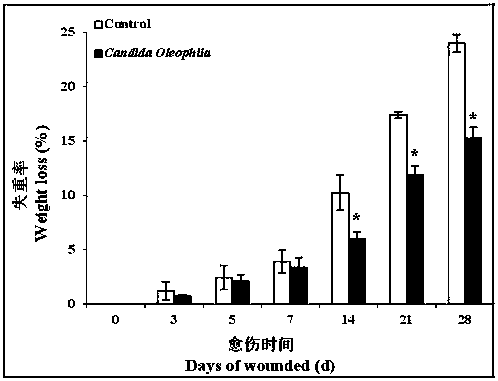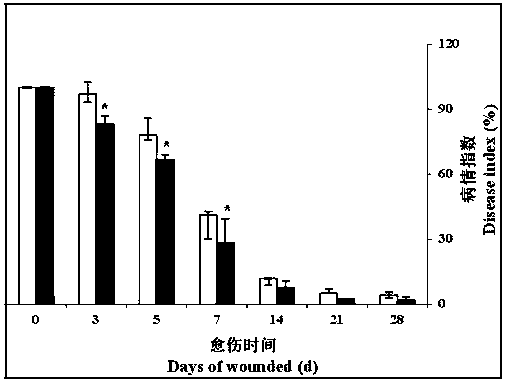Method of adopting candida olive to promote wound healing of postharvest potato tuber
A technology for olive candid silk and potato pieces, applied in the agricultural field, can solve problems such as pesticide residue environment and pollution, and achieve the effects of enhancing disease resistance, healthy and environmentally friendly postharvest callus, and promoting postharvest callus.
- Summary
- Abstract
- Description
- Claims
- Application Information
AI Technical Summary
Problems solved by technology
Method used
Image
Examples
Embodiment 1
[0025] Example 1. Potato tubers were processed according to the following steps:
[0026] A. Inoculate Candida olivaceus on the slope of the nutritional yeast glucose solid medium (NYDA) for the initial activation. The activation temperature is 28℃ and the activation time is 2 days. The activated Candida olivaceus is prepared with sterile water Yeast suspension;
[0027] B. Inoculate the yeast suspension prepared in step A into the nutrient yeast glucose liquid medium (NYDB), culture it for 24 hours at a temperature of 28°C and a rotation speed of 220r / min; re-inoculate the cultured yeast into the nutrition Yeast glucose liquid medium (NYDB) was continued to be re-cultured at a temperature of 28°C and a rotation speed of 220r / min to obtain the target yeast suspension, and the final concentration of yeast in the target yeast suspension was adjusted to 1×10 9 cells / mL;
[0028] C. Rinse the potato tubers with tap water first, then soak and disinfect with 1% sodium hypochlorite for 2 m...
Embodiment 2
[0041] Example 2. Potato tubers were processed according to the following steps:
[0042] A. Inoculate Candida olivaceus on the slant of the nutritional yeast glucose solid medium (NYDA) for initial activation. The activation temperature is 26℃ and the activation time is 3 days. The activated Candida olivaceus is prepared with sterile water Yeast suspension;
[0043] B. Inoculate the yeast suspension prepared in step A into the nutrient yeast glucose liquid medium (NYDB), culture it for 24 hours at a temperature of 28°C and a rotation speed of 220r / min; re-inoculate the cultured yeast into the nutrition Yeast glucose liquid medium (NYDB) was continued to be re-cultured at a temperature of 28°C and a rotation speed of 220r / min to obtain the target yeast suspension, and the final concentration of yeast in the target yeast suspension was adjusted to 1×10 8 cells / mL;
[0044] C. Rinse the potato tubers with tap water first, then soak and disinfect with 1% sodium hypochlorite for 2 minut...
Embodiment 3
[0046] Example 3. Potato tubers were processed according to the following steps:
[0047] A. Inoculate Candida olivaceus on the slope of the nutritional yeast glucose solid medium (NYDA) for the initial activation. The activation temperature is 30℃ and the activation time is 2 days. The activated Candida olivaceus is prepared with sterile water Yeast suspension;
[0048] B. Inoculate the yeast suspension prepared in step A into the nutrient yeast glucose liquid medium (NYDB), culture it for 24 hours at a temperature of 28°C and a rotation speed of 220r / min; re-inoculate the cultured yeast into the nutrition Yeast glucose liquid medium (NYDB) was continued to be re-cultured at a temperature of 28°C and a rotation speed of 220r / min to obtain the target yeast suspension, and the final concentration of yeast in the target yeast suspension was adjusted to 1×10 6 cells / mL;
[0049] C. Rinse the potato tubers with tap water first, then soak and disinfect with 1% sodium hypochlorite for 2 m...
PUM
 Login to View More
Login to View More Abstract
Description
Claims
Application Information
 Login to View More
Login to View More - R&D
- Intellectual Property
- Life Sciences
- Materials
- Tech Scout
- Unparalleled Data Quality
- Higher Quality Content
- 60% Fewer Hallucinations
Browse by: Latest US Patents, China's latest patents, Technical Efficacy Thesaurus, Application Domain, Technology Topic, Popular Technical Reports.
© 2025 PatSnap. All rights reserved.Legal|Privacy policy|Modern Slavery Act Transparency Statement|Sitemap|About US| Contact US: help@patsnap.com



